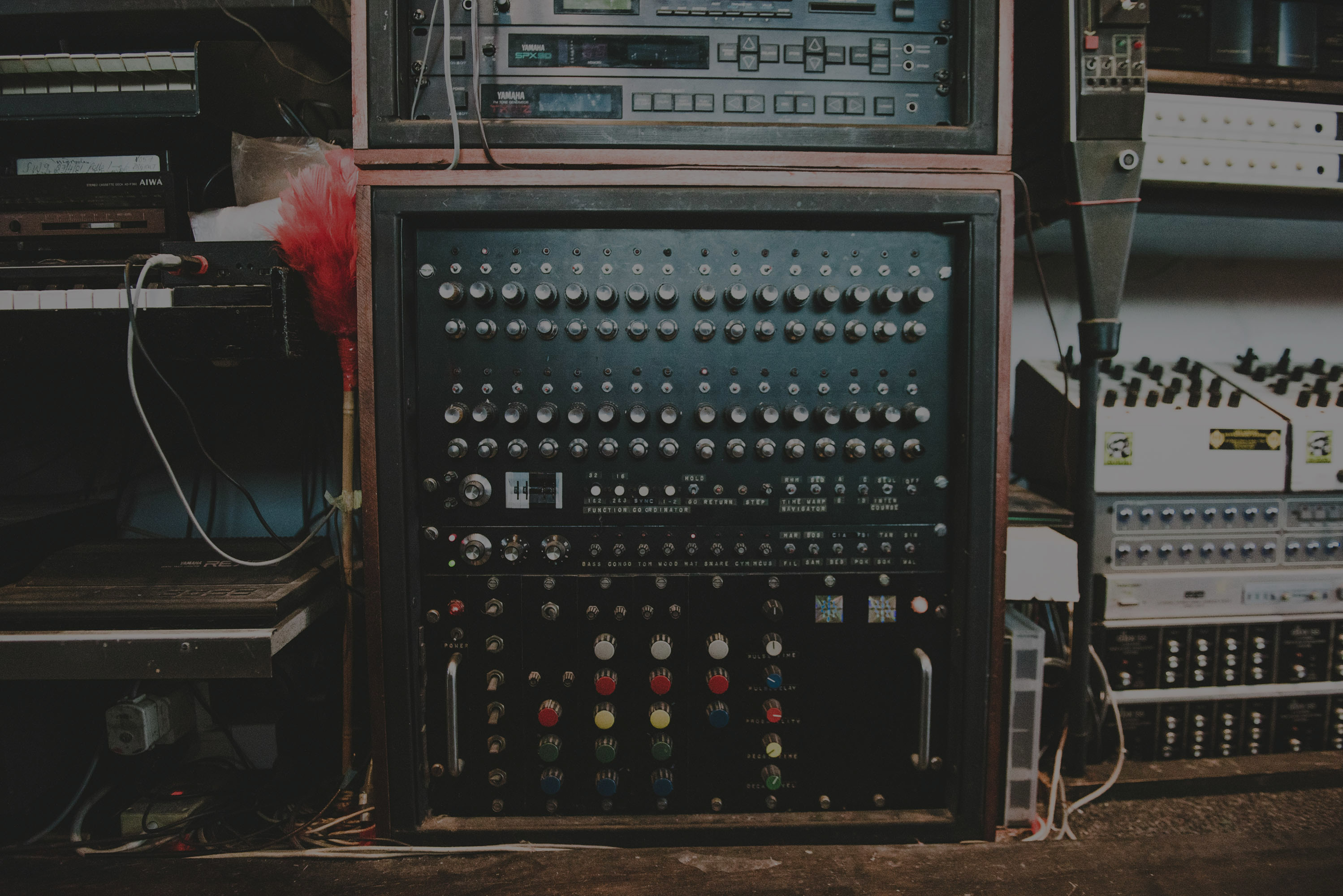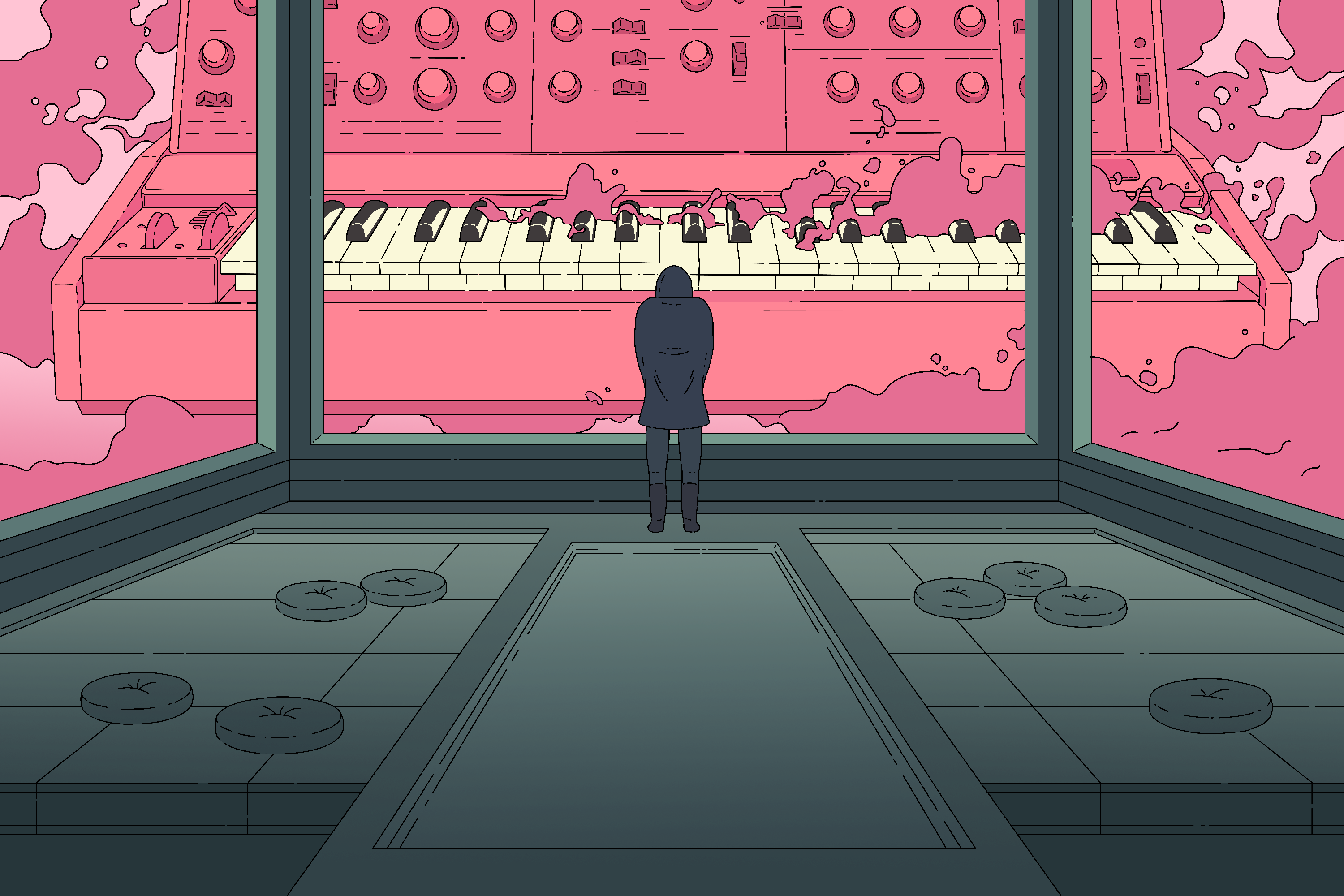Roland By The Numbers
The ’80s were rich with developments in the synthesizer and drum machine world that changed the way music was produced and heard. The instruments created by the Roland Corporation of Japan – what is now known as the x0x series – are integral to the legacy of the records they helped create. In many instances, the units were intended to be an accompanist for rehearsing or composing; it is safe to say that the designers did not imagine the revolutions in music they would help fuel. The drums did not sound like an acoustic drum kit, which led to many machines being discarded and resold in pawn shops — they were picked up by DJs and producers who would use them to invent new genres. Since most of these machines were produced in limited quantities of around 10,000, their secondhand market prices continue to rise, leading both hardware and software manufacturers to attempt to clone, imitate, and even expand on the original blueprints. Every one of these boxes is a classic in its own right, something that no set of samples can ever replace.
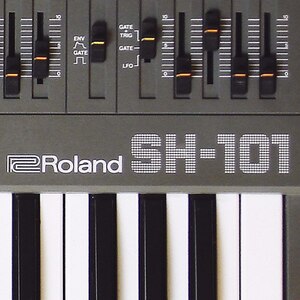
SH-101 [1982]
The plastic-encased, battery-powered, 32-key SH-101 is a monophonic analog synth that excels at basses and leads. With a very similar synthesis design to the MC-202, it has a single VCO with sliders that control levels for its saw, square, and sub oscillator waveforms. The square wave has an adjustable pulse width that can also be modulated by the LFO and the sub osc is selectable either one or two octaves below the fundamental. Its low-pass filter is capable of some wild self-oscillation and can be modulated from by the LFO or ADSR. One place where the 101 differs from the 202 is the inclusion of noise as a sound source. Another is the SH-101’s LFO having four selectable waveforms versus the 202’s sine-only design and a pitch bender/mod wheel that can be used for expressive modulations while playing the keyboard. The 101 has a simple, syncable sequencer up to 100 steps and a basic up, down, or up/down arpeggiator. On the back panel are 1/8” connectors for CV/Gate in/out and hold. Available in grey, red, or blue, the SH-101 could be worn with a strap and also used with a handle like a keytar to evoke the early ’80s from whence it came. There have been a few software clones of the 101 and most recently, Roland created a “plug out” version of their own that works with the new AIRA series System 1 keyboard. It is also apparent that the Arturia Brute series synthesizers draw some influence from the 101 and 202. Juan McLean calls it his favorite synth and claims that he and James Murphy have three or more 101s in their live rigs. Long before that, A Guy Called Gerald used the SH-101, triggered by the TR-808, to create the acid house classic “Voodoo Ray” in 1988.
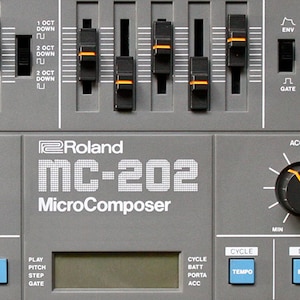
MC-202 MicroComposer [1983]
Essentially an SH-101 in a more compact enclosure, the MC-202 MicroComposer replaces full-size keys with two octaves of rubber buttons and upgrades the sequencer considerably. This is not to say that sequencing is very easy on the 202; when compared to any number of groove boxes that came later from Roland or other manufacturers, this unit can be a bit frustrating to say the least. The trade-in is the analog synth voice that it sequences and the 1-in/2-out DIN-sync connectivity to other Roland boxes. In addition to CV/Gate control on the back, tape in/out provides a way to save and recall sequences. This was cleverly used by the people at Defective Records to create MC-202 Hack, a software that allows for a Mac or PC to be used to create sequences. Probably because there is no mod wheel, the 202 has an LFO delay that the 101 does not, enabling the modulation to kick in after a note has been held for a while. The MC-202 has its similarities to the TB-303, and on the secondhand market it costs about half, making it a more reasonable option for many. For the more adventurous, many modifications are possible to the MC-202, essentially making it modular, with CV jacks for many of the synth controls and inputs/outputs at many points in the signal path. Notable users Autechre make frequent mention of the MC-202 as part of their setup.
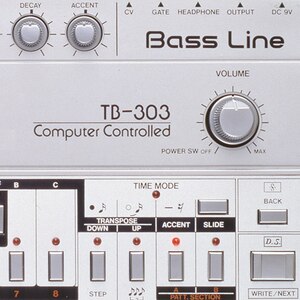
TB-303 Bass Line [1982]
Not much can be said about the 303 that hasn’t been said already. The little silver box was, almost comically, designed to sound like an electric bass player, and was initially a failure from a business perspective. Instead it launched entire movements, sub-genres, and styles with its 3-pole filter and single oscillator design – the sound of acid. Chicago’s Phuture are often considered the first to create an acid house song with the seminal “Acid Tracks,” where they tweaked the filter beyond the manufacturer’s probable intentions to bring out the squelch that has been heard countless times since. With batteries, the memory can store 64 patterns that can be chained to form seven songs, but one bar loops are most common. Also one of the most definitive features is the ability to have accent and slide turned on or off per step. These sequenceable pitch bends and accents are largely responsible for the sound of this box. The 303 is often processed with a bit of distortion for an extra taste of harmonics. There are many modifications that expand the somewhat limited synthesis capabilities of the original unit – the Devilfish and Borg mods are some notable choices. Because of its scarcity and high demand, there are probably more clones of the 303, both hardware and software, than any other synth. Notably the new Cyclone Analogue TT-303 looks like an exact replica. Also popular are the x0xb0x and the Future Retro Revolution. Roland recently released the comparatively inexpensive yet digital TB-3, another member of the AIRA series, with a pressure-sensitive touch pad and sounds that mimic the original while also going way beyond it.
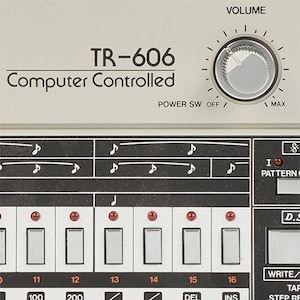
TR-606 Drumatix [1982]
Designed side by side with the 303 was its rhythmic companion, the TR-606. It’s an analog beatbox with seven sounds and a single 1/4” output. There’s individual level knobs for kick, snare, cymbal, and accent, while two toms and the open and closed hi hats utilize two level controls. The 606 kit has a similar sound to the TR-808 with less control over sound parameters. The sequencer is the 16-step format made famous by the Roland units and the memory can store 32 patterns with the ability to chain up to four of them together. There’s also room for eight songs in its memory. Unlike its Roland drum machine brethren, it’s able to jump between patterns while in write mode, useful for improvising live without pressing stop. The 606 has one DIN sync in and out for connecting to other Roland boxes. Acidlab, maker of several Roland x0x series clones, might be the first to release a TR-606 clone before 2014 is over. A cheaper alternative is the Boss DR-110, which sounds strikingly similar, although sync is only available with a modification. Many mods are possible for the TR-606 that include adding MIDI, individual outputs, inputs, additional trig outs, and timbral changes galore. A listen to Plastikman's first album Sheet One is a surefire way to hear a whole lot of 606. Aphex Twin, Squarepusher, Massive Attack, and a host of others also made heavy use of this machine.
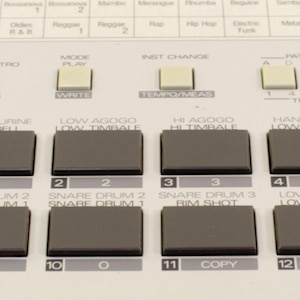
TR-626 Rhythm Composer [1987]
Possibly the least coveted and least known of the lot is the TR-626, which uses 12-bit digital samples of 30 different acoustic drum kit and Latin percussion sounds. Although not as heralded as its predecessors’ kits, apply a little processing and there’s definitely something useful for everyone here. The 626 has stereo main outs (but no panning) plus eight individual outputs. Sounds are tunable seven semitones in either direction and volume adjustable via buttons, rather than knobs or sliders. The sequenced rim shot sends a pulse out of the 1/8” trig output, which can be useful for sequencing synths that have CV. The sequencer is very similar to the TR-707 and the 727, with the non-backlit LCD display utilizing dots to show where notes occur. Three different levels of accent are possible for each sequencer step. MIDI is available on the unit for triggering sounds, plus a beat clock. There is a rather sizable portion of the front panel, which circuit benders will find useful for adding a variety of switches, jacks, and pots. As demonstrated by the guys at Burnkit2600, easy access to the 32-point sample chip allows the samples to be mangled in all sorts of ways. Even more affordable, and also popular with the modders, is the TR-505 (released in 1986) which has only a stereo output and 16 non-tunable sounds. You can’t exactly spot the 626 in a lot of famous songs, but Front 242 used the machine, specifically on 1988's “Circling Overland.”

TR-707 & 727 Rhythm Composers [1984]
These two units are basically the same in their design and sequencing, but they have different sample banks: the TR-707 has the usual acoustic drum kit components plus cowbell and tambourine while the TR-727 has all Latin percussion sounds (bongos, congas, timbales, etc.). Each unit has 15 sounds in its memory. The orange and tan 707 is sometimes considered the “poor man’s 909,” since its hi-hats, clap and cymbals are very similar. The only sound parameter available on the 707 is volume, adjustable via small sliders on the top panel, and all its sounds are digital samples (8-bit mostly, with 6-bit cymbals). The 909 is both analog and digital. Both units use the LCD matrix sequencer screen for a clear representation of the programmed pattern. Sixty-four patterns and four songs can be stored in the memory which is doubly expandable with the M-64C cartridge. These machines can send/receive MIDI notes and beat clock and also have DIN sync in & out. Similar to the 626, there’s an 1/8” trig out on the 707 that the rim shot sequences. The back panel has a host of 1/4” jacks with ten individual outputs, stereo outs, a headphone jack, and a start/stop trigger. Legend has it that Larry Heard used the trigger output to sequence the Juno 60 on his Mr. Fingers classics for Trax Records, while INXS used the 707 kit on the mainstream hit “Need You Tonight.”
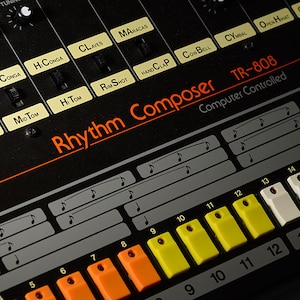
TR-808 [1980]
The granddaddy of them all was also the first to use 16-step sequencing, containing the bass drum that put the “boom” in hip hop and electro from the very beginning. The 808 uses analog synthesis to generate its tones, which may be the key to its huge sound — its kit is quite possibly used on more hit records than any other drum machine. The signature bass drum has controls for tone; actually, a CV trigger that creates an attack sound and a decay knob that extends the trunk-shaking kick. The crispy snare, hand clap, hats, cymbals, and cowbell are all instantly recognizable. Tunable toms and congas make melodies within the percussion tracks. All of the 12 voices have volume controls and individual outputs, and there’s three trig outs. Up to 64 patterns and 12 songs can be stored, with 16 of those patterns used as drum fills. A single DIN sync connection can be switchable to master or slave but it is not difficult to install a MIDI retrofit. First appearing on Yellow Magic Orchestra’s live version of “1,000 Knives,” the 808 really crept into the world’s consciousness in 1982 when Arthur Baker and Afrika Bambaataa reprogrammed the beat from Kraftwerk’s “Numbers” to make the b-boy anthem “Planet Rock.” Marvin Gaye’s Sexual Healing, also released in ’82, was a mainstream album that utilized the 808 for all of its drum sounds. Juan Atkins also used it in his early years (as Cybotron), as did his Detroit contemporaries. Egyptian Lover made it his staple drum sound on the West Coast, and the Beastie Boys, LL Cool J, and nearly all Miami bass producers made sure it dominated the East. Over the years there have been many hardware and software clones with varying authenticity, but there’s nothing quite like the real thing.
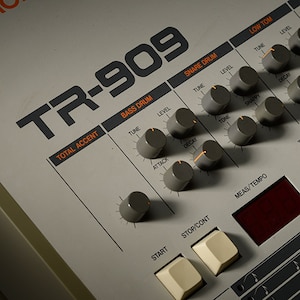
TR-909 Rhythm Composer [1983]
Although the Roland machines can be heard on records of all genres, the 909 kit is mostly associated with the history of techno and house. It has a hit-you-in-the-chest kick drum that is more punchy than booming, as well as an open hi hat with adjustable decay that sounds perfect on the upbeat every time. The bass drum, snare, three tunable toms, claps, and rimshot are all analog-produced, while the hats, ride, and crash are 6-bit samples. Like the 808, each of the 12 drum voices have volume pots and individual outputs that remove them from the main output when a cable is inserted. Most of the instruments have other sound parameters too; only the rim shot and claps do not. The 909’s seven different levels of swing contributed to the funky feel of countless house records — while this feature was not available on the 808 or 606, it was later implemented in the 707 and 727. Mods for tuning the hi hats and extending the range of the bass drum exist and aren't difficult to pull off, if you’re comfortable with messing with what is now a very expensive machine. The 16 pattern/instrument keys are like old-school computer keyboard keys with an LED in the top center and are the most playable of the x0x series. Up to 96 patterns and eight songs are storable in the memory and that is expandable with the 64C cartridge. One key feature of the 909 is that it has DIN sync in, MIDI in, and two MIDI out ports, making it connectable to several machines. Mantronix and Schoolly-D are notable hip hop artists to use the 909 kit while pretty much all techno producers (especially from Detroit and Chicago) have utilized is classic sound. Jeff Mills has been known to destroy a dancefloor with a 909 between the decks.
